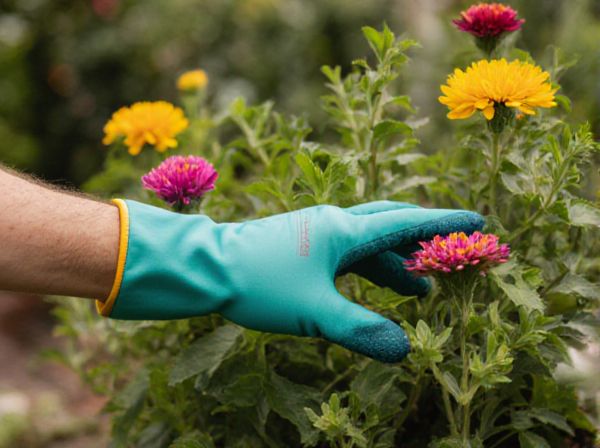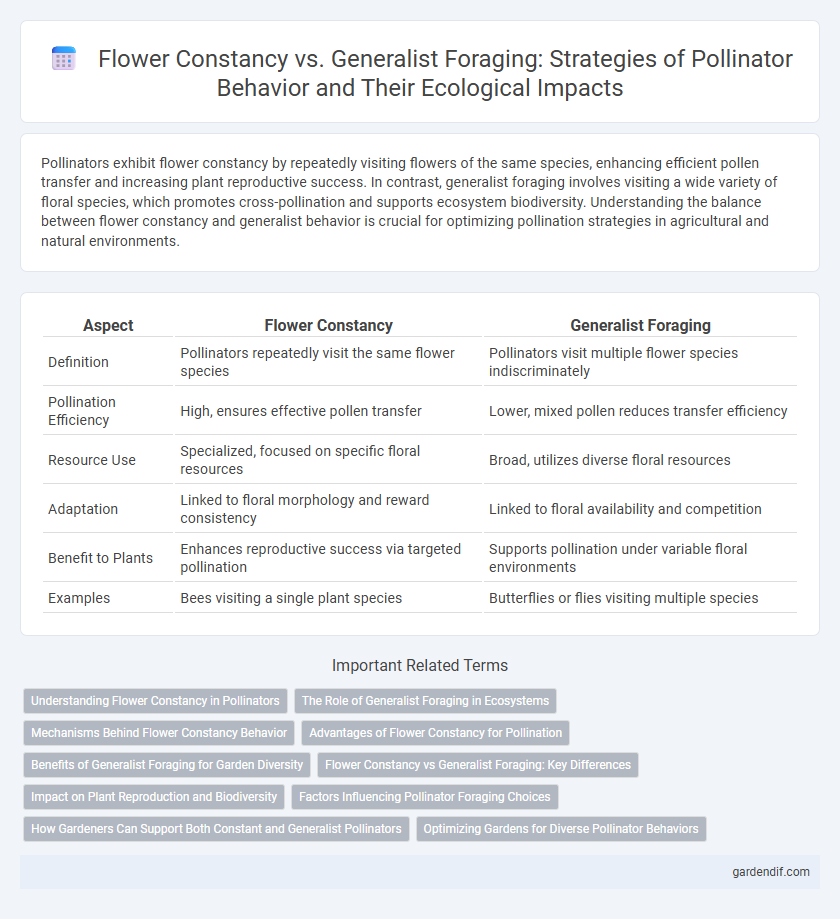
Flower Constancy vs Generalist Foraging Illustration
Pollinators exhibit flower constancy by repeatedly visiting flowers of the same species, enhancing efficient pollen transfer and increasing plant reproductive success. In contrast, generalist foraging involves visiting a wide variety of floral species, which promotes cross-pollination and supports ecosystem biodiversity. Understanding the balance between flower constancy and generalist behavior is crucial for optimizing pollination strategies in agricultural and natural environments.
Table of Comparison
| Aspect | Flower Constancy | Generalist Foraging |
|---|---|---|
| Definition | Pollinators repeatedly visit the same flower species | Pollinators visit multiple flower species indiscriminately |
| Pollination Efficiency | High, ensures effective pollen transfer | Lower, mixed pollen reduces transfer efficiency |
| Resource Use | Specialized, focused on specific floral resources | Broad, utilizes diverse floral resources |
| Adaptation | Linked to floral morphology and reward consistency | Linked to floral availability and competition |
| Benefit to Plants | Enhances reproductive success via targeted pollination | Supports pollination under variable floral environments |
| Examples | Bees visiting a single plant species | Butterflies or flies visiting multiple species |
Understanding Flower Constancy in Pollinators
Flower constancy in pollinators refers to the consistent preference for visiting flowers of the same species during foraging trips, enhancing pollination efficiency by reducing pollen waste and promoting plant reproductive success. This behavior contrasts with generalist foraging, where pollinators visit multiple flower species, potentially lowering pollen transfer precision but increasing resource diversity. Understanding flower constancy involves examining cognitive processes, memory retention, and energy optimization strategies that drive pollinators to specialize temporarily despite the availability of diverse floral resources.
The Role of Generalist Foraging in Ecosystems
Generalist foraging enhances ecosystem resilience by promoting pollination across diverse plant species, ensuring stability even when specific floral resources fluctuate. These pollinators support genetic diversity by transferring pollen among various plants, which is critical for ecosystem adaptability and productivity. Their flexible foraging behavior enables sustained pollination services, maintaining plant community dynamics and overall biodiversity.
Mechanisms Behind Flower Constancy Behavior
Flower constancy in pollinators is driven by cognitive mechanisms such as memory retention and learning, which enable efficient foraging by reducing handling time and improving nectar extraction from specific flower types. Sensory feedback and neural constraints limit switching between flower species, reinforcing preference for familiar floral cues. This behavior enhances pollination efficiency and plant reproductive success by promoting consistent pollen transfer within species.
Advantages of Flower Constancy for Pollination
Flower constancy enhances pollination efficiency by ensuring consistent pollen transfer between flowers of the same species, reducing cross-species pollen waste. This behavior increases the likelihood of successful fertilization and higher seed set in plants. Pollinators exhibiting flower constancy also optimize their foraging energy by learning and specializing in flower handling techniques specific to particular plant species.
Benefits of Generalist Foraging for Garden Diversity
Generalist foraging by pollinators enhances garden diversity by increasing the range of plants visited, promoting cross-pollination among multiple species. This behavior supports ecosystem resilience and improves plant reproduction rates across various flowering plants. By visiting diverse floral resources, generalist pollinators contribute to a balanced and thriving garden ecosystem with abundant biodiversity.
Flower Constancy vs Generalist Foraging: Key Differences
Flower constancy refers to a pollinator's tendency to visit the same flower species repeatedly during foraging, enhancing pollination efficiency by promoting pollen transfer within species. In contrast, generalist foraging involves visiting a wide variety of flower species, increasing floral resource diversity but potentially reducing pollination precision. These key differences affect plant reproduction dynamics and pollinator behavior, influencing ecosystem biodiversity and stability.
Impact on Plant Reproduction and Biodiversity
Flower constancy, where pollinators consistently visit the same plant species, enhances effective pollen transfer and increases plant reproductive success by reducing pollen wastage. Generalist foraging, involving visits to multiple plant species, promotes cross-pollination and supports biodiversity by enabling gene flow across diverse plant populations. Balancing flower constancy and generalist behaviors in pollinators is crucial for maintaining ecosystem stability and plant community resilience.
Factors Influencing Pollinator Foraging Choices
Pollinator foraging choices are influenced by factors such as flower resource availability, nutritional quality, and energetic efficiency, leading some pollinators to exhibit flower constancy by repeatedly visiting the same species to maximize foraging efficiency. Floral traits including color, scent, and morphology interact with pollinator sensory preferences and cognitive constraints, reinforcing constancy. Environmental variables like competition, predation risk, and temporal resource fluctuations further drive the balance between specialist constancy and generalist foraging strategies.
How Gardeners Can Support Both Constant and Generalist Pollinators
Gardeners can support flower-constant pollinators by planting diverse native flowering plants that bloom sequentially, providing consistent options for species like bees and butterflies that prefer specific flowers. Incorporating a variety of nectar-rich plants and maintaining untended areas encourages generalist pollinators, such as some flies and beetles, to forage widely across different blooms. Providing continuous floral resources and habitat diversity promotes pollinator health and biodiversity, enhancing ecosystem resilience.
Optimizing Gardens for Diverse Pollinator Behaviors
Flower constancy enables pollinators, such as bees, to efficiently gather nectar by repeatedly visiting the same flower species, enhancing pollination effectiveness for those plants. Generalist foraging, exhibited by species like butterflies and flies, promotes cross-pollination across diverse plant types, increasing overall garden biodiversity. Optimizing gardens involves planting a mix of flower species that support both flower-constant and generalist pollinators, ensuring robust pollination networks and improved ecosystem resilience.
Flower Constancy vs Generalist Foraging Infographic

 gardendif.com
gardendif.com